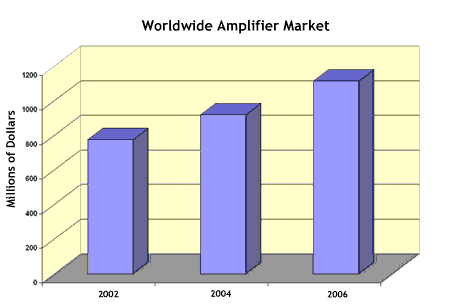A CIR report says deployment of metro optical amplifiers won't take off until 2005. Can startups wait that long?
April 17, 2002

The market for optical amplifiers -- components that boost the power of optical signals -- will grow slowly from $700 million in 2002 to reach $1.1 billion in 2006. So says market analyst firm Communications Industry Researchers Inc. (CIR) in a report published recently (see CIR: Amps to Take Off in 2005).
There are several things to note about CIR's forecast. For one, its figures are much lower than those from other analysts. Just a few short months ago, for instance, Cahners In-Stat/MDR predicted that the amplifier market would be worth $4.7 billion in 2006 (see Optical Amp Growth Seen).
Sign of the times? Or just a different methodology? CIR analyst Lawrence Gasman says he doesn't know for sure. But he does say that CIR's forecast is a cautious one. "Every time I look at the demand for optical networks in terms of the number of channels and number of fibers lit up, I just don't see it." Right now, the majority of amplifiers deployed in fiber optic networks are for inline amplification, he says. Inline amps are placed at intervals along an optical fiber to counteract the attenuation in the optical signal caused by losses in the fiber (see Optical Amplification).
Right now, the majority of amplifiers deployed in fiber optic networks are for inline amplification, he says. Inline amps are placed at intervals along an optical fiber to counteract the attenuation in the optical signal caused by losses in the fiber (see Optical Amplification).
So, for new amplifiers to be required, a new fiber or a significant number of new channels on a fiber must be lit. There's a replacement market as well, but it's rather small, according to Gasman.
Several things can make the numbers look bigger. CIR's report counts individual amplifier components and subsystems -- the stuff sold by vendors such as Corning Inc. (NYSE: GLW) and JDS Uniphase Inc. (Nasdaq: JDSU; Toronto: JDU) to the systems houses. One way to double or triple the numbers is to count the price of amplifier systems sold to carriers (they cost more than the sum of their parts).
However, this doesn't give the correct picture of the real market opportunity open to components companies, Gasman avers. And that was the point of the report.
Analysts have a habit of finding as many things as they can and adding them in, he adds, pointing to a recent OSS market forecast from RHK Inc. (see RHK's Fat OSS and Billing Software Market Worth $30B?). "Everybody likes to put out big numbers," says Gasman, "including us. I'd be lying if I said that we didn't look for other things to add. But we've got to keep it relevant."
Over-optimism about when carriers will embrace new technologies, such as Raman Amplification and Semiconductor Optical Amplifiers (SOAs) , will also boost the forecast, he says. Raman amplifiers are very expensive, costing as much as $30,000 apiece, according to Gasman, so adding in a few of those bumps up the numbers considerably.
Additionally, he suggests, if SOAs can be produced in volume at costs below $1000 per device, it could open up an entirely new market. At that price it would be possible to put amplifiers on every port, using them as single-channel pre-amplifiers to increase the reach of the optical link. But he doesn't see that happening anytime soon.
In fact, CIR doesn't believe that new technologies will make much of an impact until 2005. Many of the low-cost amplifier technologies being developed by both established players and startups target metro networks, and CIR's current research suggests that metro ring deployment isn't going to be significant until 2004 at the earliest (see Vendors Unveil Amplifier Advances).
All this adds up to a swell of bad news for amplifier startups. Not only could their overall market opportunity be smaller than perhaps they anticipated, but they will likely have to wait until 2005 before they see any real spending on their products. That's a long time to keep a company in a holding pattern.
In Gasman's view, many of the startups founded during the bubble years will run into trouble. But he also says that there's a bunch of newer startups coming along with more realistic business plans, that realise they will have to wait a few years before they can see revenues. These companies have a better chance of survival. He picks Genoa Corp., which makes SOAs, and Onetta Inc., which makes Erbium Doped-Fiber Amplifiers (EDFAs), as two startups he thinks will endure.
— Pauline Rigby, Senior Editor, Light Reading
http://www.lightreading.com
You May Also Like









